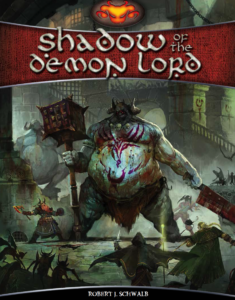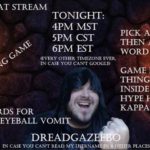I’ve been talking up Shadow of the Demon Lord for what feels like forever now, and I figured it was about time to start backing it all up with some reasons. So today, I’m starting out with my top ten things that I love about the game, and why if you haven’t played it yet you’re seriously missing out. Alright, let’s do this!
1.) It’s awesome if you’re lazy, and phenomenal if you’re not.
The game is built for people who have little-to-no prep time, the target number of sessions for a SotDL campaign is 10. Throughout those 10 sessions / adventures* you should see your group rise and make their mark on the world. Obviously, the inverse of this is true also, you can dump as much sweet sweet preparation as you want into your SotDL game and reap amazing benefits as well. I’m just glad it caters to my layabout tendencies.
*I say sessions or adventures because depending on how much your group spends bullshitting, for me it usually takes 2 sessions per adventure because we’re chatty.
2.) The Path system is brilliant.
Paths in Shadow of the Demon Lord are like classes in other games, except in Demon Lord multiclassing is just part of the game. Don’t worry, I don’t mean ‘multiclassing’ in that “hire a CPA to fill out your character sheet” sort of way, but just in the way that you get to pick multiple cool things to be as your characters progress. Once you evolve from a level 0 scrub who simply has an ancestry (similar to race), you’ll pick a Novice path, later on down the road you’ll pick expert and master paths, grabbing up features and abilities from each as you progress. It really makes for dynamic and unique characters that I haven’t seen any other tabletop RPG do this well.
3.) Simple mechanics.
In Demon Lord, the task resolution mechanics are simple and it uses the old faithful d20. Want to hit an enemy? Just hit their defense attribute and you’re good. Want to perform a task? Make a challenge roll, which is simply a static target number of 10. Did you roll a 10 or better? Hooray, then you did the thing! That’s it. These rolls are obviously influenced by situation circumstances specific to the game and characters, but are also modified by boons and banes. These are d6 rolls that modify your d20 roll by being added or subtracted from its result, you can learn more about them here.
4.) It’s math-light and there’s no XP to track.
Speaking of characters progressing, how about a game that doesn’t use XP? Nope. None. The whole party just levels up when the GM feels it’s warranted, usually after a significant accomplishment – which is typically right after an adventure is completed. There are 4 core stats, each of which have an ability modifier, but that’s it. All of the numbers are right there on the surface, none of them are buried, and you’ll never be stopping the flow of the game to calculate things.
5.) The setting is malleable.
The Demon Lord is a hulking, terrible, world-threatening entity in the game’s default setting, but it doesn’t have to be. Yes the game is a dark fantasy RPG with similar tonalities to the Warhammer universe, but there’s really not much from stopping you from making the “Demon Lord” a Lovecraftian horror, an ancient vampire, a god, or even an exponentially growing hivemind of savage madmen. The game wouldn’t have quite the same ring to it if it was called “Shadow of the Big Bad Thing”.
6.) The subsystems are extremely useful and terribly simple.
Do you want a Lovecraftian game? Gothic horror? Steampunk? A blasted out Mad Max-esque wasteland? You can do it with SotDL. It also has sanity and corruption mechanics that take up no more than about 1 page a piece as far as rules are concerned. The magic system is full of flavor, effectual, modular, simple, and easy to understand without having to give players a history lesson in “Vancian magic”.
7.) Combat is swift and collaborative.
The initiative system in Demon Lord works in turns, players choose whether their character is taking a fast or a slow turn. A slow turn (a move and an action), and a fast turn (a move or an action) are your options. Player characters always go before monsters, and fast turn users always go before slow turn users. So in short, combat rounds go in this order: Fast PCs > Fast Monsters > Slow PCs > Slow Monsters. As for what actual order the players and monsters go in within their own turn, is up to them and it can change every turn. Do they want to coordinate their attacks to play out in a certain order, let them have it! You can do the same with the monsters as a GM!
8.) Scale, lethality, and the twist on classic fantasy is perfect.
Demon Lord is an unforgiving game, but not in that Dark Souls sort of way. There is a real threat of death all throughout a campaign, but that doesn’t mean the game is out to get them. There is a very balanced sense of risk versus reward in Demon Lord and its published products. There’s a great sense of starting out as a “regular” and growing into a masterful purveyor of whatever paths your pursue. Surviving level 0 can be harrowing, but totally doable as long as players remember their characters aren’t heroes of any sort. Yet.
The twist on classic fantasy tropes is unlike any others I’ve seen, yet they are familiar enough that no one comes to table telling you that they’re playing a sentient pile of rocks or a living factory that manufactures psychic widgets. It’s like the porridge in Goldilocks, it’s all just right. Except in Demon Lord’s case, Goldilocks’ porridge is tainted with an awful sickness that turns her into a ravenous monster and she eats the bears when they get home.
9.) The adventures! Holy crap, the adventures!
If you’re familiar with Savage Worlds’ One Sheets, then you’ll appreciate Demon Lord’s adventures. The published modules for Demon Lord are all about 4-8 pages long and simply outline everything the GM needs to run the adventure. Bullet points, motivations, history, events, and outcomes. They’re easily and quickly read and digested. This is perhaps, my absolute favorite thing about the game.
They aren’t like D&D modules in that they are brief and to the point. They also don’t hold your hand, and won’t make you jump back and forth all over the place to find the info you need as a GM. Everything is always right there in front of you, and they always give just enough background to leave the GM salivating with dozens of juicy story hook ideas if they want to roll their own. Not too much background though, unlike other games that make you feel boxed in, you can make Demon Lord your own because it was intended to be that way.
10.) Despite its dark demeanor, Demon Lord aims to please by actively encouraging collaboration and saying “yes” to its players.
From the book, to the player: “…Unless something interesting interferes with that activity, it happens as you stated and the story continues.” I’m not sure I’ve seen a game so robust, yet so simple, while simultaneously being unobtrusive and undemanding of those playing it. It’s just the culmination of so many great things that empower GMs and players and I just can’t get enough of it. There’s a great fortune mechanic too, similar to Inspiration in D&D, but it does a bit more and is rewarded a bit more often. It basically boils down to “Do something cool, gain fortune”. Which in turn can turn a failure into a success, help an ally, boost a die roll, or whatever else the GM sees fit.
 Overall, Shadow of the Demon Lord is an extremely fun, satisfying, palatable, evocative, and collaborative RPG that really brings groups together. We didn’t even scratch the surface here really, but if you want a little more in-depth guide on how to play from a beginner’s standpoint be sure to check out Black Candle Games’ Beginner’s Guide. Honestly, this is my favorite tabletop RPG and I don’t see that changing anytime soon.
Overall, Shadow of the Demon Lord is an extremely fun, satisfying, palatable, evocative, and collaborative RPG that really brings groups together. We didn’t even scratch the surface here really, but if you want a little more in-depth guide on how to play from a beginner’s standpoint be sure to check out Black Candle Games’ Beginner’s Guide. Honestly, this is my favorite tabletop RPG and I don’t see that changing anytime soon.
[su_note note_color=”#fcfcd7″]Interested and want to take the plunge before the full review? Demon Lord is just $20 or less for the core book, which is everything you need, right now on DriveThruRPG! Also, as a shameless plug, you consider picking up some of my work for the game: He Sees You When You’re Sleeping, Tales of the Desolation, and Insupposable Instruments.[/su_note]



Pingback: It’s the End of the World as We Know It, and I Feel Fine (part 1) | Alphastream
Pingback: Review: Xanathar’s Guide to Everything – The Dread Gazebo
Pingback: Adventure: He Sees You While You’re Sleeping – The Dread Gazebo
Pingback: Adventure: He Sees You When You’re Sleeping – The Dread Gazebo
Thank you! This was a great review, and you’ve sold me to take a closer look at this game!
Pingback: The Pagecount Fallacy – The Dread Gazebo
Pingback: Beginner's Guide to Shadow of the Demon Lord - Black Candle Games
Pingback: He Sees You When You’re Sleeping 5e Conversion Guide. – The Dread Gazebo
Pingback: He Sees You When You’re Sleeping 5e Conversion Guide. – Dread Gazebo TEST
Pingback: Where Have I Been? – The Dread Gazebo
Pingback: The Importance of Benightedness in Fiction – The Dread Gazebo